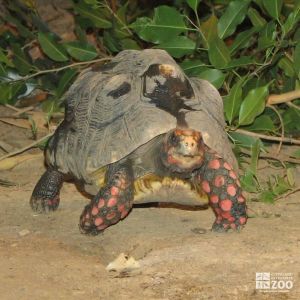Red-Footed Tortoise
[Chelonoidis carbonaria]

The average adult carapace of the Red Footed Tortoise is 10 to 13 inches long with a record length of 17-3/4 inches. The carapace is black (occasionally dark brown) with yellow to reddish orange vertebral areas. A light spot of the same color occurs at the base of each marginal. Distinct curving of the sides give a waist-line look. The plastron is yellowish brown with some dark pigment along the mid transverse seams. Some males will be very dark within the concave portion. The anterior surface of the limb is covered with large red non- or slightly overlapping scales. The color may vary from deep scarlet to orange and even yellow in some specimen.
Location: Animals Formerly at Zoo
Share:
Range
The range of the red footed tortoise is northern and central South America.
Habitat
The red footed tortoise inhabits humid forest and moist savannas.
Conservation Status
Primary Threats
Gestation
Incubation: 105 to 202 days
Litter
Clutch: 5-15 eggs
Behavior
Eggs and young red footed tortoises are vulnerable to attacks from many species include tegu lizards, crocodilians, many species of birds, cats, and coatis. large tortoises can fall prey to jaguars and man. They are endangered because of their popularity in the pet industry.
Reproduction
Breeding season for red footed tortoises is usually July to September in the wild, but in captivity, they breed all year. Males use head movements (a series of jerks away from and back to mid position - first to one side then the other) to distinguish themselves from other males. They will sniff the female's cloaca to determine if it is the same species. Ramming and pushing may be used to subdue the female. Females will dig a flask-like cavity approximately 8 inches deep to deposit the eggs, which are elongated with brittle shells.
Wild Diet
Grasses, succulent fallen fruit, occasional carrion
Zoo Diet
Endive, spinach, carrots, grapes, bananas, leafeater diet
